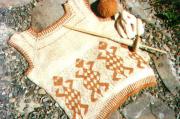How to Join Yarn
How to Join Yarn
There are several different ways to attach yarn while you are knitting. None of them are "right" or "wrong." But they fulfill different needs.
Tie a knot: One simple method is to just tie a knot joining the end of the used-up skein with the beginning of the new skein. The advantage of this join is that it is very secure and will not unravel later during repeated wearing and washing. The disadvantage is that you have to be careful to get the knot rested in the back of your work. It may, at some time, poke through the front and look tacky. It also creates a little bump (not good for the bottom of socks!), and it leaves two ends flapping around down there are the back of your work. Those ends will have to be worked in later (use a large needle and weave each end in as best you can). You can also choose to cut the ends off fairly close to the knot and just leave them. Many Andean type sweaters join all their colors with knots, and don't even bother to work in the ends.
Just start knitting: You can just start knitting with the new color, leaving both ends hanging on the back of your work, and come back to work them in later. This is not as secure as the knot, but will never pop through. If you do a good job of working the ends in later it will be nice and secure and invisible.
Double up: Knit with both the old yarn and the new yarn for a several stitches, then drop the old yarn and continue on with the new yarn. This is a great solution if you do not like working in the ends later. Knit at least six stitches, then clip the ends off short. The disadvantage to this method is that with a bulky yarn the 6 sts knit with the double yarn will make a bump in your knitting. It also cannot be used when changing colors.
Any of these methods can be done in the middle of the row or at the beginning or end of a row. The disadvantage of doing it in the middle of the row is that you may end up with a bump that can be seen. The disadvantage of doing it at the beginning of a row is that you may get a bumpy edge, and you also have to waste that last end of yarn because it will be a rare moment when you run out of yarn right at an edge.
You could also just get really really really long yarn and never have to join!!!
Connie Delaney



